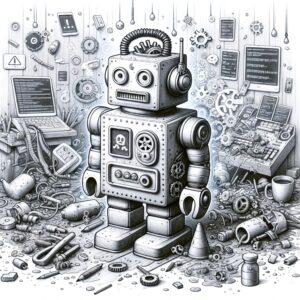
In today’s rapidly evolving technological landscape, artificial intelligence (AI) systems are increasingly integral to various facets of daily life and industry operations. From healthcare diagnostics to autonomous vehicles and personalized digital assistants, AI’s capabilities are vast and varied. However, as these systems become more complex and autonomous, the legal and ethical questions surrounding accountability when these systems fail or cause harm grow more pressing. This blog post delves into the intricacies of who is held accountable when AI systems malfunction, focusing on product liability, negligence, and the challenges of attributing fault.
The Quandary of AI Accountability
Unlike traditional systems, AI’s decision-making processes can be opaque, driven by algorithms that learn and evolve over time. This adaptability, while a hallmark of AI’s innovation, complicates the task of pinpointing responsibility for malfunctions or harmful outcomes. The central legal concepts in these scenarios are product liability and negligence, each offering a different lens through which to view accountability.
Negligence and the Duty of Care
Negligence involves a failure to take proper care in doing something, leading to damage or injury to another. In the context of AI, this could pertain to a company failing to adequately test an AI system before deployment, or not updating it to address known vulnerabilities. The legal challenge here lies in establishing the standard of care expected in the development and deployment of AI systems, a standard that is still evolving given the novelty and complexity of the technology.
The duty of care might extend to continuous monitoring of the AI system’s performance and making necessary adjustments, a significant departure from the “release and forget” approach seen in some traditional product deployments. This ongoing duty reflects the unique nature of AI systems, whose behavior can change over time, influenced by new data and experiences.
Product Liability and AI
Product liability refers to a manufacturer or seller being held liable for placing a defective product into the hands of a consumer. Traditionally, this involves tangible products; however, AI systems challenge these boundaries, existing as both software and, in some cases, integrated into physical products. When an AI system causes harm, determining the defect—be it in design, manufacturing, or inadequate warnings—becomes complex. For instance, if an autonomous vehicle’s AI system fails to recognize a stop sign due to a flaw in its object recognition algorithm, is the vehicle’s manufacturer liable for the resulting accident?
The challenge here is multifaceted. AI systems are often the product of contributions from multiple entities, including software developers, data providers, and hardware manufacturers. Furthermore, an AI system’s learning capability means it can evolve beyond its initial programming, raising the question: when does the liability of the developer end and the user’s begin?
The Challenges of Attributing Fault
Attributing fault in incidents involving AI is fraught with challenges. The distributed nature of AI development and deployment means that responsibility is often shared among various stakeholders, including AI developers, users, data providers, and even the entities responsible for the AI’s training data. This distribution of responsibility dilutes accountability, making it difficult for injured parties to seek redress.
Moreover, the “black box” nature of many AI systems, where the decision-making process is not transparent, makes it hard to understand why an AI system made a particular decision. This opacity challenges the legal system’s ability to apply traditional fault analysis, which relies on understanding the cause of a malfunction or injury.
Moving Forward: Adapting Legal Frameworks
The challenges of AI accountability necessitate a reevaluation of existing legal frameworks to accommodate the unique characteristics of AI systems. Possible solutions include creating new legal standards specifically tailored to AI, implementing more stringent testing and certification processes for AI systems, and developing AI systems with explainability in mind to aid in fault analysis.
Furthermore, there is a growing discussion around the concept of “electronic personhood” for AI systems, which would not only redefine accountability but also raise profound ethical and legal questions about the rights and responsibilities of AI entities.
Conclusion
As AI continues to integrate into various sectors, the need for clear legal frameworks to address accountability in the event of failures or harm becomes increasingly critical. Balancing innovation with safety and ethical considerations will require a collaborative effort among technologists, legal experts, policymakers, and society at large. The journey to navigate the legal maze of AI accountability is complex, but it is a necessary one to ensure the responsible and equitable advancement of AI technologies.
